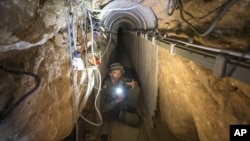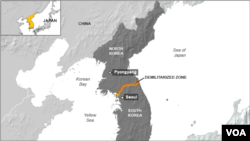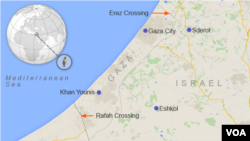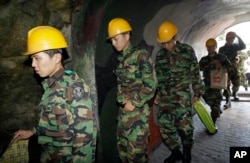The Palestinian militant group Hamas may have drawn global attention for using tunnels in its latest war with Israel, but the Gaza Strip isn’t the only place where digging has factored into an ongoing conflict.
Just look east to the divided Korean Peninsula.
North Korea is suspected of having as many as 20 cross-border attack tunnels under the Demilitarized Zone, or DMZ, some South Korean and U.S. security analysts say.
South Korean officials base their suspicions on testimony from North Korean defectors, some of whom claimed to have built the passages, say analysts such as Go Myong-Hyun, a researcher at the Asan Institute for Policy Studies in Seoul.
South Korean forces and their U.S. allies have found only four infiltration tunnels – three in the 1970s, one in 1990. But the South Korean Defense Ministry continues to be on the alert for more.
"We don’t ignore even the smallest signs of a possible tunnel because these tunnels could determine the outcome of a war and our country’s survival," it told The New York Times in a faxed statement in 2012.
Meanwhile, at least one South Korean company, the Panmunjom Travel Center, offers a specialized DMZ tour that includes an “infiltration tunnel” visit.
For decades, some South Korean individuals have looked for cross-border tunnels, too – but critics accuse them of using unscientific methods and wasting money and effort.
But there’s no disputing the tunnels that both Hamas and North Korea have built, in their own territories, for defensive purposes.
Other similarities can be found between the North Korean tunnels and those in Hamas-run Gaza, as well as between the forces trying to locate them. But, there are significant differences, too.
Going on offense
Both Hamas and Pyongyang have built cross-border tunnels in pursuit of the same military objective: to sneak their fighters behind enemy lines and hurt enemy morale.
In the current Israel-Hamas conflict, Israeli forces staged a ground offensive against Gaza militants from July 17 to August 5, destroying 32 tunnels, 14 of which crossed into Israel. Militants used the tunnels to ambush and kill 11 Israeli soldiers on Israeli territory.
Hamas has described the tunnels as strategic weapons in its decades-long fight against Israel.
Israeli authorities have accused Hamas of plotting to use the tunnels to kill civilians in small Israeli communities near the Gaza border.
As for North Korea, its founder and supreme leader, Kim Il Sung, had called for tunneling under the DMZ, which stretches approximately four kilometers or 2.5 miles wide and 240 kilometers or 150 miles long.
The tunnels were intended to give North Korea the capability to send thousands of soldiers to exit points several kilometers south of the DMZ, behind South Korea’s front-line combat posts, said David Maxwell, a retired U.S. Army Special Forces colonel who served in South Korea.
"If North Korean infiltrators were dressed in South Korean uniforms, and also attacked U.S. forces near the DMZ, that would have a devastating effect on the trust between the U.S. troops and their South Korean allies," said Maxwell, now an analyst at Georgetown University’s Center for Security Studies in Washington.
Maxwell said such guerrilla tactics have long been a part of North Korean military doctrine.
Tunnels as defense
The U.S. and Israeli militaries suspect Pyongyang and Hamas have built many more tunnels for a different purpose: protecting their military assets from aerial assault.
In 2012, Brig. Gen. Neil H. Tolley, then-commander of all U.S. special operations forces in South Korea, said at a special-ops industry conference that North Korea had hidden its military infrastructure in an underground network. He estimated the network includes 20 subterranean air bases, National Defense magazine reported.
Reports from North Korean defectors and satellite imagery indicate Pyongyang has built thousands of tunnels into mountains and hillsides to house artillery, ammunition and medical supplies, said Maxwell, the Georgetown security analyst.
"For weaker sides in conflicts, the best defense traditionally has been the earth," Maxwell said. "It provides cover, and the deeper you go, the harder it is for enemy bombs to penetrate."
In July, the Israel Defense Forces’ official blog said Hamas had created an "underground city of terror,” with "dozens" of access points located throughout Gaza. "Hamas uses these tunnels as weapons caches, bunkers, command centers and a concealed transportation artery for terrorists and weapons."
Bruce Bechtol, a political science professor at Texas-based Angelo State University, said Hamas apparently had outside help in building its tunnels.
"Their complexity leads one to believe that they probably were built with North Korean assistance, because most people don't have the know-how," said Bechtol, who previously served as a U.S. Marine and intelligence officer.
Neither North Korea nor Hamas has acknowledged any transfer of tunnel expertise. But, the two have a common ally, Iran, which has built underground sites to protect its nuclear program from potential aerial attacks.
Itamar Yaar, former deputy head of Israel's National Security Council, said Iran has engaged in close military contacts with North Korea in recent years, while also sending advisers to Gaza to help Hamas.
"I would be very surprised if the Iranians were helping Hamas to dig the Gaza tunnels without using the North Korean connections," Yaar said.
What sets Gaza's tunnels apart
Pyongyang's fingerprints are less visible in Hamas' cross-border attack tunnels, which have key differences from the four found under the Korean DMZ, said Israeli defense analyst Eado Hecht.
"Gaza's offensive tunnels are very narrow and militants have to move in single file, while the North Korean infiltration tunnels are big enough for people to walk three to five abreast," he said.
Terrain makes a difference, too.
"The Palestinians have been digging through flat sands, not through mountainous rock, as in Korea," Hecht said.
Much of Gaza, which borders the Mediterranean, is at sea level – so the deeper the dig, the greater the chance that underground water will undermine tunnel stability. Reinforcement “makes the process more expensive and time consuming,” Hecht said, noting Hamas tunnels reach a depth of only 20 to 30 meters, or 66 to 98 feet.
In contrast, North Koreans’ four infiltration tunnels go through the DMZ’s hills and mountains, reaching depths of 50 to 150 meters, or 164 to 492 feet.
Hecht said Hamas also typically waits until it intends to use an attack tunnel before digging an exit point, while Pyongyang's four unused infiltration tunnels had openings on the South Korean side of the border.
Palestinians started tunneling in Gaza long before receiving any alleged help from outsiders, said Hecht, who teaches military history at several Israeli universities.
"Gaza clans began digging cross-border smuggling tunnels into Egypt's Sinai peninsula almost two decades ago, learning through trial and error and making huge profits” from smuggled goods, he said.
Gaza smugglers have built about 1,800 tunnels, of which more than 1,600 have been destroyed by Egyptian security forces mostly in the past year, Hecht said. Other smuggling tunnels have caved in or been damaged by Israeli air strikes.
Detection efforts continue
Efforts to locate attack tunnels built by North Korea and Hamas have been underway for years.
Maxwell, the retired U.S military officer, was part of a detection team in South Korea in the 1980s, he said.
"While we were patrolling the DMZ, one of our priorities was to report possible tunnel construction sounds, such as the use of explosives, and try to locate a tunnel by drilling deep into the earth and placing sensors in certain locations," he said.
Davis Florick, a graduate student specializing in East-West studies at Nebraska's Creighton University, said South Korean and U.S. search teams continue to conduct spot checks along the border.
"They use electronic wave machines to send pulses into the ground in case the pulses hit a tunnel wall and refract back to the surface," Florick said. "They also use seismographs to monitor earth movements that could indicate if a tunnel is being dug."
In Israel, authorities have revealed few details about how they uncovered dozens of Hamas tunnels in the latest conflict. Israeli officials have said they are examining various technologies that could help them detect other infiltration tunnels.
Yaar, who retired from Israel's National Security Council in 2008, said the Israeli government has been aware of the North Korean tunnels in the DMZ and shared knowledge with South Korea, a military ally.
But, it is not clear if the two sides have cooperated on tunnel-detection technology.
The South Korean government did not respond to a VOA request for comment, while the U.S. military force in South Korea declined any comment on "operational or intelligence matters."
Differing challenges
Israeli experts have concluded that some technologies used elsewhere are not effective in finding Gaza's tunnels because of its sandy soil, Yaar said.
Another difference between tunnel detection in South Korea and Israel is the level of importance the two nations attach to the mission.
Florick said Seoul has to deal with bigger strategic threats than the DMZ tunnels.
"North Korea's nuclear weapon and missile programs demand greater attention from South Korea and the United States," he said. "But it makes sense for Israel to focus on the Gaza tunnels, because they are one of the only means by which Palestinian militants can be resupplied with weapons, other than ships."
Go, the South Korean researcher, said North Korea's recent emphasis on developing weapons of mass destruction suggests it has shifted away from tools of conventional warfare.
"Once you build a tunnel and infiltrate commandos, you cannot use it again because it will be discovered," Go said.
"The North Koreans spent a lot of effort on the four known DMZ tunnels, but didn't get much use out of them," he said. "So, I suspect that they probably stopped building tunnels after the 1990s."



